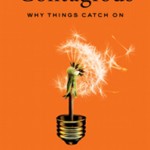Marketing professor explores popularity of things
Posted by Elena del Valle on May 6, 2016

Contagious
Photos: Simon & Schuster, Deborah Feingold
Jonah Berger, Ph.D., who teaches marketing at the Wharton School at the University of Pennsylvania, is convinced popular topics share identifiable commonalities. After spending 15 years studying and researching how social influence works and how it drives products and ideas to catch on he thinks he has uncovered some of the reasons that people talk more about some products and ideas than others. In Contagious Why Things Catch On (Simon & Schuster, $14.69), a New York Times bestseller title published in 2013 and named Best Marketing Book of 2014 by the American Marketing Association, he outlines his theories on the topic.
He says that while people don’t pay attention to advertisements, they listen to their peers. In his book, which took more than 10 years from idea to publication, he outlines six basic principles he is convinced drive things to become popular. He describes them as Social Currency, Triggers, Emotion, Public, Practical Value, and Stories.
Following an introductory chapter, he dedicates a chapter to each of the principles in his 244-page hardcover book. He cites examples of how a steakhouse executive got buzz for his restaurant by adding a luxury sandwich to his menu, why anti-drug commercials may have increased drug use, and why 200 million consumers shared a video about a blender.

Johan Berger, author, Contagious
He wrote the book for “anyone who wants to get something to catch on. Might be a small business owner with a new service, a marketing manager launching a new product, or someone who wants to get others to change their behavior.”
When asked by email how he defines contagious for marketing purposes the marketing professor said it is “something that spreads from person to person via word of mouth.”
He shares surprising tidbits. For example, in the Leverage Game Mechanics section, he discusses how less than 10 percent of the estimated 10 trillion frequent flyer miles remain unused. In the Make People Feel Like Insiders section, he talks about the new found popularity of the McDonald’s McRib, which despite its name is made mostly of tripe, heart and stomach meat.
His second book, Invisible Influence: The Hidden Forces that Shape Behavior, on a similar topic is due out June 2016. One of the biggest challenges to writing and publishing the book, he said, was pulling all the research together.

Click to buy Contagious









